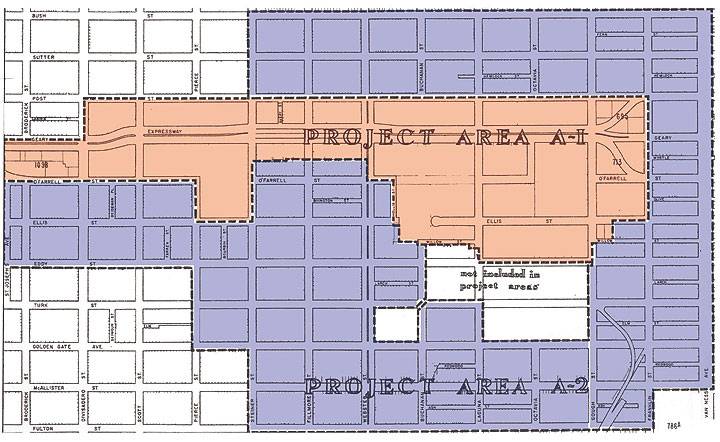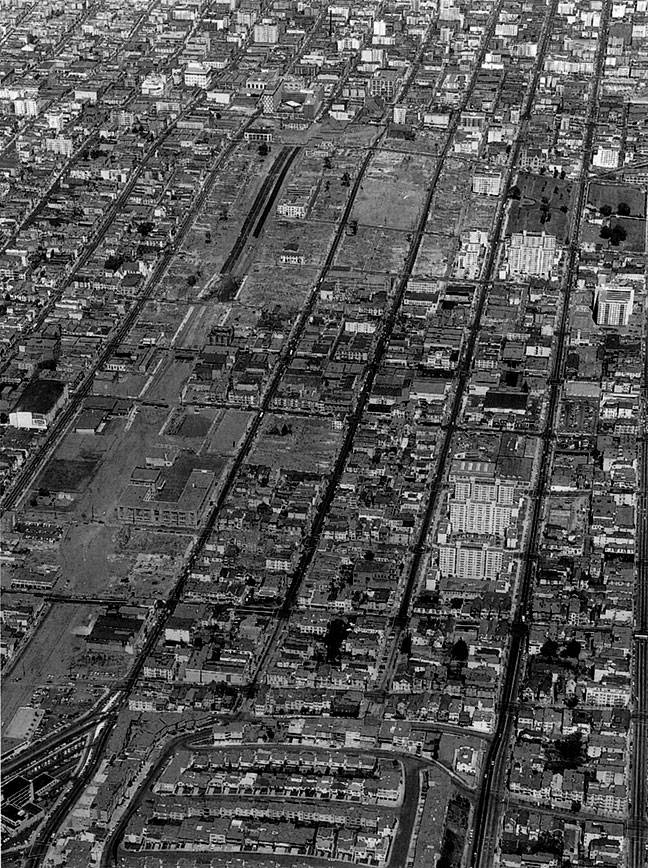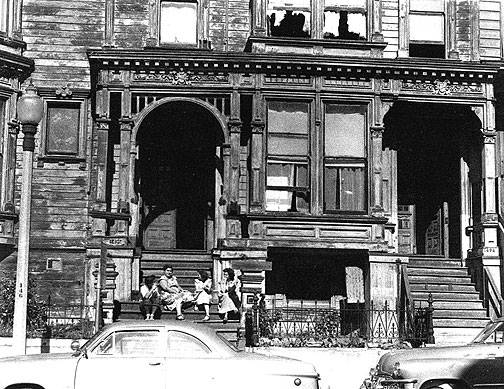Fillmore Redevelopment: Difference between revisions
changed credit on Aero photographs, whose rights were transferred from the SFRA to the SFPL (per Christina Moretta) |
mNo edit summary |
||
| (One intermediate revision by one other user not shown) | |||
| Line 18: | Line 18: | ||
''photo: Ed Brady'' | ''photo: Ed Brady'' | ||
[[Image:Aerial Fillmore early 1970s SFRDA aaz-0828 for web.jpg|792px]] | |||
'''Aerial of the Fillmore in the early 1970s.''' | |||
''Photo: SFRDA via SF Public Library, aaz-0828'' | |||
Redevelopment was started early in WWII when future planning commissioners Morgan Gunst and Julia Porter formed the SF Planning and Housing Association (SFPHA). SFPHA published a number of influential studies, including the 1945 ''Blight and Taxes'', which first identified the Western Addition as a prime candidate for urban renewal, citing its poor health statistics, high delinquency rates and packing it with racially loaded metaphors: "[The Western Addition] is not white. It is gray, brown, and an indeterminate shade of dirty black ... it is an unfortunate blot," unlike the Marina District, which the same report described as "clean and bright". | Redevelopment was started early in WWII when future planning commissioners Morgan Gunst and Julia Porter formed the SF Planning and Housing Association (SFPHA). SFPHA published a number of influential studies, including the 1945 ''Blight and Taxes'', which first identified the Western Addition as a prime candidate for urban renewal, citing its poor health statistics, high delinquency rates and packing it with racially loaded metaphors: "[The Western Addition] is not white. It is gray, brown, and an indeterminate shade of dirty black ... it is an unfortunate blot," unlike the Marina District, which the same report described as "clean and bright". | ||
| Line 33: | Line 39: | ||
[[Image:WA Foster Klieser Bldg-now MLK Housing.jpg|720px]] | [[Image:WA Foster Klieser Bldg-now MLK Housing.jpg|720px]] | ||
'''Foster Klieser Building on Eddy between Steiner and | '''Foster Klieser Building on Eddy between Steiner and Pierce, early 1960s.''' | ||
''Photo: Aero Photographers, courtesy San Francisco History Center, San Francisco Public Library'' | ''Photo: Aero Photographers, courtesy San Francisco History Center, San Francisco Public Library'' | ||
Latest revision as of 13:22, 1 July 2024
Unfinished History
Vacant lot in the Western Addition A-2 redevelopment zone along Geary Blvd.
Photo: Aero Photographers, courtesy San Francisco History Center, San Francisco Public Library
Map of A-1 and A-2 Redevelopment Project Areas
Map: San Francisco Redevelopment Agency
Aerial shot of Western Addition A-1 in 1961
photo: Ed Brady
Aerial of the Fillmore in the early 1970s.
Photo: SFRDA via SF Public Library, aaz-0828
Redevelopment was started early in WWII when future planning commissioners Morgan Gunst and Julia Porter formed the SF Planning and Housing Association (SFPHA). SFPHA published a number of influential studies, including the 1945 Blight and Taxes, which first identified the Western Addition as a prime candidate for urban renewal, citing its poor health statistics, high delinquency rates and packing it with racially loaded metaphors: "[The Western Addition] is not white. It is gray, brown, and an indeterminate shade of dirty black ... it is an unfortunate blot," unlike the Marina District, which the same report described as "clean and bright".
Family on porch in Western Addition, c. 1959.
Photo: Kurt Bank
Its desirable location, just to the west of the Civic Center and the city's commercial core, south of the oldest, richest neighborhood, and home to several major hospitals and churches made it "potentially worth far more, for it is in the heart of a growing city, and anyone can see its latent value." (B&T). These latent values could only be acquired through co-opting opposition, opening the door to speculators.
--Chris Carlsson
Foster Klieser Building on Eddy between Steiner and Pierce, early 1960s.
Photo: Aero Photographers, courtesy San Francisco History Center, San Francisco Public Library






